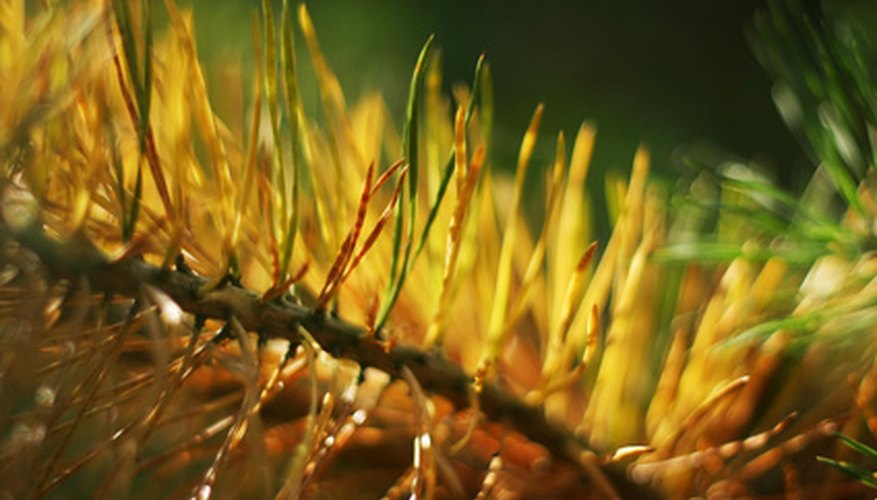Yellow needles on a pine tree can be caused by a variety of things and not always a sign that a tree is unhealthy. Although the tree may look bad, underneath the yellow could be a healthy tree or one that is damaged or diseased. A little detective work is required to determine what is causing the needles to turn yellow and what needs to be done.
Natural Causes
Yellow needles on pine trees are not always caused by disease or stress. On most evergreens, older needles naturally turn yellow or brown and fall off in the fall, but some will do it in the spring or summer. White pines are notorious for turning yellow in the fall and can appear unhealthy when their yellow needles outnumber the green ones. As long as this year's needles are green, the tree should be healthy. You can also look at the tips of the branches because pests and disease affect the needles there first, according to master gardener Paul James.
- Yellow needles on pine trees are not always caused by disease or stress.
- On most evergreens, older needles naturally turn yellow or brown and fall off in the fall, but some will do it in the spring or summer.
Injury
Injury to the branches, trunk or roots can cause pine needles to turn yellow. Sometimes the damage is obvious, but not always. High winds can twist limbs and cause internal injuries to the tree. Pine trees can also be injured if trucks drive over their roots. Signs of damage may not be immediately obvious but slowly develop six months to two years later. Unfortunately, once a pine tree is critically damaged, the only option is to remove it.
- Injury to the branches, trunk or roots can cause pine needles to turn yellow.
- High winds can twist limbs and cause internal injuries to the tree.
Needlecast
Lophodermium needlecast (or needle cast) attacks short-needled varieties of Scotch pine as well as ponderosa and red pines. The first symptoms are yellow or brown spots on the needles. Infected needles eventually drop and develop black, football-shaped fruiting bodies. Cyclaneusma needlecast infects ponderosa and Scots pines. Beginning symptoms are small, light-green spots that gradually lighten and turn the entire needle a dusty yellow.
- Lophodermium needlecast (or needle cast) attacks short-needled varieties of Scotch pine as well as ponderosa and red pines.
- Beginning symptoms are small, light-green spots that gradually lighten and turn the entire needle a dusty yellow.
Blights
Tip blight is a fungus that attacks older Austrian, ponderosa, Scots and mugo pine trees. Early symptoms include stunted shoots and needles that turn yellow or tan. Infection begins at the bottom of the tree and works its way upward. Dothistroma needle blight affects pines in the late summer or early fall by causing green bands or yellow or tan spots on the needles. Spots and bands eventually turn brown and infected needles die and drop off. Dothistroma needle blight can infect any variety, but ponderosa and Austrian pines are most susceptible to it.
- Tip blight is a fungus that attacks older Austrian, ponderosa, Scots and mugo pine trees.
- Dothistroma needle blight can infect any variety, but ponderosa and Austrian pines are most susceptible to it.
Systematic Disease
Pine wilt nematodes (Bursaphelenchus xylophilis) usually affect Scots, mugo, Japanese black and Austrian pine trees in the late summer or fall. Needles start by wilting, then turn yellow and brown. Trees usually die about 30 to 90 days after symptoms appear. Another systematic disease is white pine decline. Unlike other diseases, white pine decline seems to be caused by a several complex factors such as high soil pH level, compacted or clay soil, and restricted root area. Although the tree's location seems to be the cause, the disease is seen in older, established trees and not newly planted ones. Symptoms include shorter than normal needles that are light green or yellow.
- Pine wilt nematodes (Bursaphelenchus xylophilis) usually affect Scots, mugo, Japanese black and Austrian pine trees in the late summer or fall.
